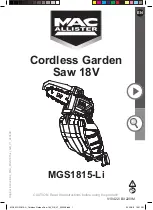
1
GENERAL OPERATIONAL PRECAUTIONS
WARNING!
When using electric tools, basic safety
precautions should always be followed to reduce the risk
of fire, electric shock and personal injury, including the
following.
Read all these instructions before operating this product
and save these instructions.
For safe operations:
1.
Keep work area clean. Cluttered areas and benches
invite injuries.
2.
Consider work area environment. Do not expose
power tools to rain. Do not use power tools in damp
or wet locations. Keep work area well lit. Do not use
power tools where there is risk to cause fire or
explosion.
3.
Guard against electric shock. Avoid body contact
with earthed or grounded surfaces. (e.g. pipes,
radiators, ranges, refrigerators).
4.
Keep children and infirm persons away. Do not let
visitors touch the tool or extension cord. All visitors
should be kept away from work area.
5.
Store idle tools. When not in use, tools should be
stored in a dry, high or locked up place, out of reach
of children and infirm persons.
6.
Do not force the tool. It will do the job better and
safer at the rate for which it was intended.
7.
Use the right tool. Do not force small tools or
attachments to do the job of a heavy duty tool. Do
not use tools for purposes not intended; for example,
do not use circular saw to cut tree limbs or logs.
8.
Dress properly. Do not wear loose clothing or
jewelry, they can be caught in moving parts. Rubber
gloves and non-skid footwears are recommended
when working outdoors. Wear protecting hair
covering to contain long hair.
9.
Use eye protection. Also use face or dust mask if
the cutting operation is dusty.
10.
Connect dust extraction equipment.
If devices are provided for the connection of dust
extraction and collection facilities ensure these are
connected and properly used.
11.
Do not abuse the cord. Never carry the tool by the
cord or yank it to disconnect it from the receptacle.
Keep the cord away from heat, oil and sharp edges.
12.
Secure work. Use clamps or a vise to hold the work.
It is safer than using your hand and it frees both
hands to operate tool.
13.
Do not overreach. Keep proper footing and balance
at all times.
14.
Maintain tools with care. Keep cutting tools sharp
and clean for better and safer performance. Follow
instructions for lubrication and changing
accessories. Inspect tool cords periodically and if
damaged, have it repaired by authorized service
center. Inspect extension cords periodically and
replace, if damaged. Keep handles dry, clean, and
free from oil and grease.
15.
Disconnect tools. When not in use, before servicing,
and when changing accessories such as blades, bits
and cutters.
16.
Remove adjusting keys and wrenches. Form the
habit of checking to see that keys and adjusting
wrenches are removed from the tool before turning
it on.
17.
Avoid unintentional starting. Do not carry a plugged-
in tool with a finger on the switch. Ensure switch is
off when plugging in.
18.
Use outdoor extension leads. When tool is used
outdoors, use only extension cords intended for
outdoor use.
19.
Stay alert. Watch what you are doing. Use common
sense. Do not operate tool when you are tired.
20.
Check damaged parts. Before further use of the tool,
a guard or other part that is damaged should be
carefully checked to determine that it will operate
properly and perform its intended function. Check
for alignment of moving parts, free running of
moving parts, breakage of parts, mounting and any
other conditions that may affect its operation. A
guard or other part that is damaged should be
properly repaired or replaced by an authorized
service center unless otherwise indicated in this
handling instructions. Have defective switches
replaced by an authorized service center. Do not use
the tool if the switch does not turn it on and off.
21.
Warning
The use of any accessory or attachment, other than
those recommended in this handling instructions,
may present a risk of personal injury.
22.
Have your tool repaired by a qualified person.
This electric tool is in accordance with the relevant
safety requirements. Repairs should only be carried
out by qualified persons using original spare parts.
Otherwise this may result in considerable danger
to the user.
PRECAUTIONS ON USING RECIPROCATING
SAW
Prior to cutting into walls, ceillings or floors, ensure there
are no electric cables or conduits inside.
Summary of Contents for CR13VC
Page 11: ...10 ...
Page 12: ...305 Code No C99117211 N Printed in Japan Hitachi Koki Co Ltd ...






























